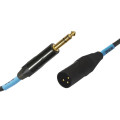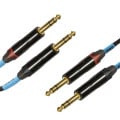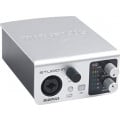- Opis
-
Szczegóły
Kali Audio IN-8 3-drożny monitor studyjnyKali Audio atakuje rynek 3-drożnych monitorów studyjnych. I czyni to w sposób bardzo przemyślany – wykorzystując współosiowe przetworniki średnio-wysokotonowe... Jak to rozwiązanie się sprawdzi? Powinno się sprawdzić znakomicie! Na dobrą sprawę, dla świadomych praw akustyki konstruktorów, to jedyna słuszna droga prowadząca do stworzenia możliwie idealnego monitora studyjnego!Współosiowy przetwornik średnio-wysokotonowy daje z punktu przewagę nad konstrukcją z klasycznymi trzema oddzielnymi przetwornikami. Dlaczego? Bo pasmo średniotonowe i wysokotonowe docierają do naszych uszu z jednego punktu i tym samym nie powstają żadne filtry grzebieniowe przy zmianie położenia naszych uszu względem monitorów.Widać, że konstruktorzy Kali Audio bardzo przemyśleli swoją nową konstrukcję! Obudowa typu bass-reflex ma port szczelinowy umieszczony z przodu – zadbano o takie wyprofilowanie wylotu, by zminimalizować zniekształcenia i przyszumy związane z dużym ciśnieniem powietrza przepływającego przez port bass-reflexu.Za przetwarzanie najniższego pasma odpowiada 8-calowy woofer z lekką membraną z papieru powlekaną polipropylenem. Na umieszczony w falowodzie przetwornik średnio-wysokotonowy składa się 4-calowy wooferek z membraną z identycznego materiału, co woofer 8” oraz wysokotonowy tweeter 1” z membraną z syntetycznego jedwabiu. Przetwornik średnio-wysokotonowy jest dzielony na 3 kHz.Konstruktorzy zadbali, aby odległość między niskotonowym wooferem 8” a średniotonowym 4” była mniejsza, niż 1/4 długości fali punktu podziału między tymi przetwornikami - podział został ustawiony na 330 Hz. To oznacza, że w połączeniu ze współosiowym przetwornikiem średnio-wysokotonowym, umieszczonym w dobrze zaprojektowanym falowodzie, monitor Kali IN-8 jest źródłem zbliżonym do punktowego. A to przekłada się na świetne pozycjonowanie przestrzenne kreowane przez dwa monitory w stereo.Monitory Kali Audio IN-8 mają przy spadku -10 dB przenosić pasmo od 37 Hz do 25 kHz. Przy tolerancji ±3 dB reprodukowane jest pasmo od 45 Hz do 21 kHz. Monitory są zasilane 3 końcówkami mocy, odpowiednio 60 W (LF), 40 W (MF) i 40 W (HF), Kali IN-8 oferują maksymalny SPL na poziomie 114 dB. Zalecana odległość tych monitorów od słuchaczy to według producenta minimum 2.8 m. Waga jednego monitora to około 10 kg. Podobnie, jak modele LP-6 i LP-8, Kali Audio IN-8 są wyposażone w DSP pozwalające na dostosowanie monitorów do akustyki pomieszczenia, w jakim mają pracować.- Klasa wzmacniacza: D
- Power Config: Tri-Amped
- Moc LF: 60 W.
- Moc MF: 40 W.
- Moc HF: 40 W.
- Całkowita moc: 140 W.
- Driver LF: 8-calowy Poli Coated Paper
- Driver MF: zoptymalizowany profil 4-calowy Poli Coated Paper
- Driver HF: 1-calowa kopuła tekstylna
- Freq. Odpowiedź (-10 dB): 37 Hz - 25 kHz
- Freq. Zakres (± 3 dB): 45 Hz - 21 kHz
- Zwrotnica LF do średniej częstotliwości: 330 Hz
- Crossover z zakresu średniego do wysokiego: 3000 Hz
- Odległość słuchania: 2,8 metra
- Maks. SPL: 114 dB
- Klasa wzmacniacza: D
- Dostawa
-
Szczegóły dostawy produktu KALI AUDIO IN-8 - 3-drożny monitor studyjny
Wysyłka z Warszawa, Polska.
Dostawa do
Jeżeli chcesz zobaczyć dokładne metody dostawy dostępne w Twojej lokalizacji, uzupełnij powyższe pola.
- Zadaj pytanie
-
Zadaj pytanie odnośnie produktu
- Recenzje (0)
-
0.0
0 recenzji
Oceń ten produkt jako pierwszy
O producencie KALI AUDIO

KALI AUDIO jest amerykańską firmą założoną w 2018 roku przez byłych pracowników JBL Pro. Wykfalifikowany i pełen pomysłów zespół angażuje się i poświeca wiele czasu, po to aby nieustannie opracowywać nowe innowacyjne rozwiązania, które zapewnią niesamowitą jakość dźwięku. Aktualnie marka zajmuje się tworzeniem m.in. głośników, subwooferów oraz monitorów studyjnych.
Firma
- Siedziba producenta: Stany Zjednoczone
- Średnia ocena produktów: 4.9
Produkty
- Liczba produktów: 26
Statystyki napraw



















